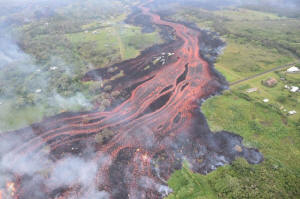|
Lava creeps onto geothermal plant site on
Hawaii's Big Island
 Send a link to a friend
Send a link to a friend
 [May 22, 2018]
By Terray Sylvester [May 22, 2018]
By Terray Sylvester
PAHOA, Hawaii (Reuters) - Molten lava from
the erupting Kilauea Volcano on Hawaii's Big Island crept onto a
geothermal power plant site on Monday, as workers rushed to shut down
the facility to prevent the uncontrollable release of toxic gases.
Crews worked into the night to cap the 11th and final well at the Puna
Geothermal Venture (PGV) plant, which provides about 25 percent of the
Big Island's power, as lava from an active fissure flowed 200 to 300
yards from the nearest well pad, county and federal officials said.
"County, state, and federal partners have been collaborating closely to
monitor the situation and work with PGV to ensure the safety of the
surrounding communities," the county said.
The race at the site marked the latest challenge facing authorities as
they cope with what geologists rank as one of the biggest upheavals in a
century from one of the world's most active volcanoes.
The latest explosive eruption at the Kilauea summit occurred shortly
before 6 p.m. local time, the Hawaiian Volcano Observatory reported.

"The resulting ash plume may affect surrounding areas," it said.
The plant has been closed since shortly after lava began erupting on May
3 through newly opened fissures in the ground running through
neighborhoods and roads on the far eastern flank of Kilauea.
Within a week, some 60,000 gallons (227,124 liters) of the highly
flammable chemical pentane, which was stored at the plant, were moved
from harm's way. The state said last week it was pumping cold water into
the wells and would cap them with iron plugs.
The plant's wells run 6,000 to 8,000 feet (1,829-2,438 meters)
underground to tap into extremely hot water and steam used to run
turbines and produce electricity.
LAZE ALERT
About 3 miles (4.8 km) to the east of the plant on the coast, noxious
clouds of acid fumes, steam and fine glass-like particles billowed into
the sky as lava poured into the ocean from two flows cutting across
Highway 137, one of the main exit routes from the eruption zone.
Laze -- a term combining the words "lava" and "haze" -- is formed when
erupting lava, which can reach 2,000 degrees Fahrenheit (1,093 degrees
Celsius), reacts with sea water. It is potentially deadly if inhaled.
[to top of second column]
|

Lava flows downhill, in this image from a helicopter overflight of
Kilauea Volcano's lower East Rift zone, during ongoing eruptions of
the Kilauea Volcano in Hawaii, U.S., May 19, 2018. USGS/Handout via
REUTERS

"If one were to be near the laze, because of the various acids, it
would be corrosive to the eyes, the nose and respiratory tract, and
the skin," Dr. Alvin Bronstein from the Hawaii State Department of
Health told journalists on a conference call.
Laze killed two people when a lava flow reached the coast in 2000,
and authorities warned residents to stay clear of it.
Another hazard was the potential for methane gas explosions as
searing lava neared pockets of rotting vegetation, igniting traces
of the flammable gas given off by the decay.
"These are quite a big hazard in vegetative areas and the explosions
can occur well away from the lava flow itself," USGS geologist Janet
Babb said on the call.
Geologists say Kilauea's eruption, which has already produced around
two dozen lava-spewing fissures, has now entered a more violent
phase, in which larger volumes of molten rock are oozing from the
ground and traveling farther than before.
At least 44 homes and other structures have been destroyed in the
Leilani Estates and Lanipuna Gardens area of the Puna district, and
a man was seriously injured on Saturday when a plate-sized chunk of
molten shot out of a fissure and struck him on the leg.
Two thousand people have been ordered from their homes due to lava
flows and toxic sulfur dioxide gas, levels of which have tripled in
the last two days, according to civil defense officials. The Hawaii
National Guard has warned of more mandatory evacuations if further
highways are blocked.

(Reporting by Terray Sylvester, additional reporting by Jolyn Rosa
in Honolulu; Writing by Andrew Hay; Editing by Sandra Maler, Joseph
Radford and Raissa Kasolowsky)
[© 2018 Thomson Reuters. All rights
reserved.]
Copyright 2018 Reuters. All rights reserved. This material may not be published,
broadcast, rewritten or redistributed.
Thompson Reuters is solely responsible for this content. |